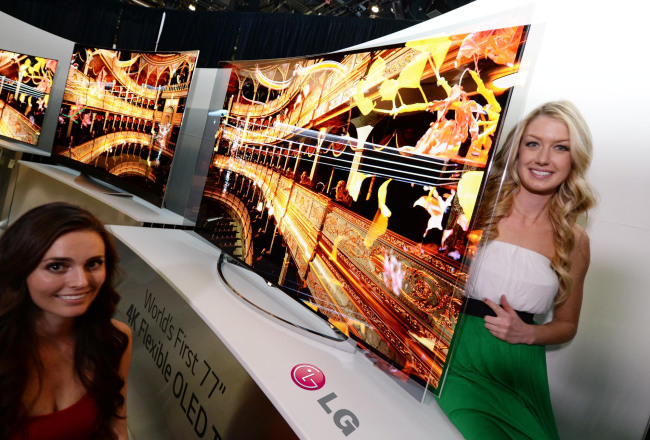 |
Models pose with LG Electronics’ flexible OLED TVs unveiled at the international CES in Las Vegas this month.(LG Electronics) |
Dominance is shifting in the global display market as Chinese companies are fast emerging to challenge Korea’s giants in advanced technology.
Korea’s liquid crystal display panels in terms of global output and shipment saw their market share slide from 48.9 percent in 2010 to 48.8 percent in 2013.
The share taken up by the Chinese players, meanwhile, jumped from 4.7 percent to 12.5 percent during the same period, according to DisplaySearch, a global display market researcher.
This impact from the Chinese rivals has also further pulled down market shares of Samsung Electronics and LG Electronics in the LCD TV market.
Six Chinese companies ― TCL, Skyworth, Hisense, Changhong, Konka and Haier ― saw their combined market share reach 24.9 percent in the third quarter of last year, outpacing Samsung Electronics’ 24.1 percent for the first time.
LG Electronics trailed far behind with 14.3 percent, according to DisplayBank.
“In recent years, Chinese companies are fast emerging in LCD panels on the back of the government’s financial and legal support,” said Chung Yoon-sung, a director of DisplaySearch.
The Chinese government is supporting its local companies to reach its goal of raising the country’s LCD self-sufficiency rate from the current 40 percent to 80 percent by 2015. It has also implemented protective measures by increasing tariffs on LCD panel imports.
The Chinese government, for instance, has provided subsidies worth 7.8 billion yuan ($1.2 billion) to China Star Optoelectronics Technology, a subsidiary of TCL, since 2010.
Korean companies have pushed to widen their technology gap by developing organic light emitting diodes and flexible OLEDs amid the rapid emergence of China’s display players.
“However, Korea’s technology development process seems to still be slow,” said Lee Sin-doo, a professor of Seoul National University’s electrical engineering and computer science department.
Samsung showcased its ultrahigh-definition TV as its flagship model instead of its OLED TV at the international CES this month.
“Although Samsung has secured a high production yield rate for OLED TVs, we stopped short of having price competitiveness,” a Samsung source said.
The price of Samsung’s 55-inch full HD OLED TV is still much higher than LCD counterparts, though it dropped to around 8-10 million won from 15 million won. Its 55-inch LCD UHD TV costs 4 million won.
LCDs cost less as manufacturers are able to produce them more stably with fewer flaws than OLEDs, an industry source said.
Korean companies should keep increasing their investments in panel technology, said Lee of Seoul National University.
“The country’s electronics makers somewhat tend to hesitate to invest in panels. In order for the Korean companies to maintain their leadership down the road, they should keep investing in panels and materials,” the professor said.
By Shin Ji-hye (
shinjh@heraldcorp.com)








